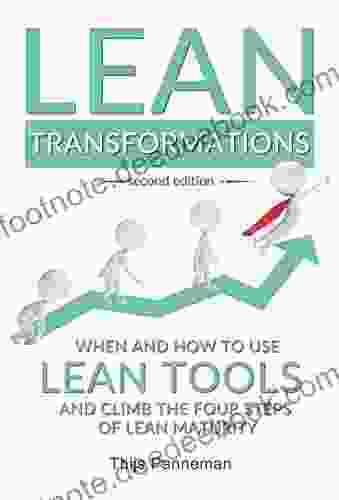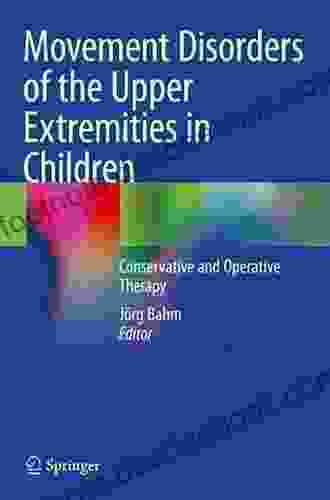Movement Disorders of the Upper Extremities in Children

Movement disorders of the upper extremities in children are a group of conditions that affect the way a child moves their arms, hands, and fingers. These disorders can range from mild to severe, and they can affect one or both arms.
There are many different causes of movement disorders of the upper extremities in children. Some of the most common causes include:
- Cerebral palsy
- Spina bifida
- Muscular dystrophy
- Autism spectrum disorder
- Traumatic brain injury
- Stroke
The symptoms of movement disorders of the upper extremities in children can vary depending on the underlying cause. However, some of the most common symptoms include:
5 out of 5
| Language | : | English |
| File size | : | 144115 KB |
| Text-to-Speech | : | Enabled |
| Screen Reader | : | Supported |
| Enhanced typesetting | : | Enabled |
| Print length | : | 655 pages |
- Difficulty reaching for objects
- Difficulty grasping objects
- Difficulty manipulating objects
- Tremor
- Dystonia
- Athetosis
- Chorea
Movement disorders of the upper extremities in children can have a significant impact on a child's ability to perform everyday activities. These disorders can make it difficult for children to eat, dress, play, and write. They can also lead to social and emotional problems.
The treatment for movement disorders of the upper extremities in children depends on the underlying cause. There is no cure for most movement disorders, but there are treatments that can help to improve a child's symptoms. These treatments may include:
- Physical therapy
- Occupational therapy
- Speech therapy
- Medication
- Surgery
The prognosis for children with movement disorders of the upper extremities varies depending on the underlying cause. Some children may experience significant improvement with treatment, while others may have more persistent symptoms. However, with early diagnosis and treatment, most children with movement disorders of the upper extremities can learn to live full and active lives.
Types of Movement Disorders of the Upper Extremities in Children
There are many different types of movement disorders of the upper extremities in children. Some of the most common types include:
- Cerebral palsy is a group of movement disorders that are caused by damage to the brain that occurs before or during birth. Cerebral palsy can affect one or both arms, and it can range from mild to severe.
- Spina bifida is a birth defect that occurs when the spinal cord does not close all the way during pregnancy. Spina bifida can affect the arms, legs, and trunk, and it can range from mild to severe.
- Muscular dystrophy is a group of genetic disorders that cause progressive muscle weakness. Muscular dystrophy can affect the arms, legs, and trunk, and it can range from mild to severe.
- Autism spectrum disorder is a neurodevelopmental disorder that affects a child's ability to communicate and interact with others. Autism spectrum disorder can also affect a child's motor skills, including their ability to move their arms and hands.
- Traumatic brain injury is an injury to the brain that is caused by a blow to the head. Traumatic brain injury can affect any part of the brain, including the areas that control movement.
- Stroke is a sudden loss of blood flow to the brain. Stroke can affect any part of the brain, including the areas that control movement.
Symptoms of Movement Disorders of the Upper Extremities in Children
The symptoms of movement disorders of the upper extremities in children can vary depending on the underlying cause. However, some of the most common symptoms include:
- Difficulty reaching for objects
- Difficulty grasping objects
- Difficulty manipulating objects
- Tremor
- Dystonia
- Athetosis
- Chorea
Difficulty reaching for objects is one of the most common symptoms of movement disorders of the upper extremities in children. Children with this symptom may have difficulty reaching for toys, food, or other objects that are out of reach.
Difficulty grasping objects is another common symptom of movement disorders of the upper extremities in children. Children with this symptom may have difficulty picking up objects, holding them securely, or releasing them.
Difficulty manipulating objects is a symptom of movement disorders of the upper extremities in children that can make it difficult for children to perform everyday activities. Children with this symptom may have difficulty eating, dressing, playing, and writing.
Tremor is a type of involuntary shaking that can affect the arms, hands, or fingers. Tremor can make it difficult for children to perform everyday activities.
Dystonia is a type of involuntary muscle contraction that can cause the arms, hands, or fingers to twist or turn into unusual positions. Dystonia can make it difficult for children to perform everyday activities.
Athetosis is a type of involuntary muscle movement that can cause the arms, hands, or fingers to move slowly and writhingly. Athetosis can make it difficult for children to perform everyday activities.
Chorea is a type of involuntary muscle movement that can cause the arms, hands, or fingers to move quickly and jerkily. Chorea can make it difficult for children to perform everyday activities.
Diagnosis of Movement Disorders of the Upper Extremities in Children
The diagnosis of movement disorders of the upper extremities in children is based on a physical examination and a review of the child's medical history. The doctor may also order imaging tests, such as an MRI or CT scan, to rule out other conditions.
Treatment of Movement Disorders of the Upper Extremities in Children
The treatment for movement disorders of the upper extremities in children depends on the underlying cause. There is no cure for most movement disorders, but there are treatments that can help to improve a child's symptoms. These treatments may include:
- Physical therapy
- Occupational therapy
- Speech therapy
- Medication
- Surgery
Physical therapy can help children with movement disorders of the upper extremities to improve their range of motion, strength, and coordination. Physical therapy can also help children to learn how to use their arms and hands more effectively.
Occupational therapy can help children with movement disorders of the upper extremities to learn how to perform everyday activities, such as eating, dressing, playing, and writing. Occupational therapy can also help children to develop compensatory strategies for their movement difficulties.
Speech therapy can help children with movement disorders of the upper extremities to improve their speech and language skills. Speech therapy can also help children to learn how to use their mouths and tongues more effectively.
Medication can be used to treat some of the symptoms of movement disorders of the upper extremities in children. Medications can help to reduce tremor, dystonia, athetosis, and chorea.
Surgery may be an option for children with severe movement disorders of the upper extremities. Surgery can be used to correct muscle imbalances, release tight muscles, or lengthen tendons.
Prognosis for Children with Movement Disorders of the Upper Extremities
The prognosis for children with movement disorders of the upper extremities varies depending on the underlying cause. Some children may experience significant improvement with treatment, while others may have more persistent symptoms. However, with early diagnosis and treatment, most children with movement disorders of the upper extremities can learn to live full and active lives.
5 out of 5
| Language | : | English |
| File size | : | 144115 KB |
| Text-to-Speech | : | Enabled |
| Screen Reader | : | Supported |
| Enhanced typesetting | : | Enabled |
| Print length | : | 655 pages |
Do you want to contribute by writing guest posts on this blog?
Please contact us and send us a resume of previous articles that you have written.
 Novel
Novel Page
Page Chapter
Chapter Story
Story Genre
Genre Paperback
Paperback E-book
E-book Newspaper
Newspaper Paragraph
Paragraph Sentence
Sentence Shelf
Shelf Glossary
Glossary Bibliography
Bibliography Preface
Preface Synopsis
Synopsis Annotation
Annotation Scroll
Scroll Codex
Codex Bestseller
Bestseller Library card
Library card Biography
Biography Encyclopedia
Encyclopedia Dictionary
Dictionary Resolution
Resolution Catalog
Catalog Card Catalog
Card Catalog Borrowing
Borrowing Archives
Archives Study
Study Lending
Lending Reserve
Reserve Journals
Journals Special Collections
Special Collections Literacy
Literacy Dissertation
Dissertation Storytelling
Storytelling Awards
Awards Reading List
Reading List Book Club
Book Club Theory
Theory Editors Of Ulysses Press
Editors Of Ulysses Press Jw Wilson
Jw Wilson Heather Gardam
Heather Gardam Kurt Daw
Kurt Daw Angie Dortch
Angie Dortch Edward Vilga
Edward Vilga Paul Oliver
Paul Oliver Frederic Austin Ogg
Frederic Austin Ogg Guy Smith
Guy Smith M H Rice
M H Rice Vinod Khosla
Vinod Khosla Joos Korstanje
Joos Korstanje Siobhan Nash Marshall
Siobhan Nash Marshall Kalyani Vallath
Kalyani Vallath Gilbert Rozman
Gilbert Rozman Benjamin Brad Dison
Benjamin Brad Dison Mark R Levin
Mark R Levin Amy Clipston
Amy Clipston Bella Matthews
Bella Matthews Amy Daws
Amy Daws
Light bulbAdvertise smarter! Our strategic ad space ensures maximum exposure. Reserve your spot today!

 Efrain PowellAn Extraordinary Canine: The Inspiring Story of Dog Called Valentine Roxanne...
Efrain PowellAn Extraordinary Canine: The Inspiring Story of Dog Called Valentine Roxanne... Rex HayesFollow ·4.1k
Rex HayesFollow ·4.1k Javier BellFollow ·13.8k
Javier BellFollow ·13.8k Corey GreenFollow ·18.3k
Corey GreenFollow ·18.3k Rick NelsonFollow ·2.3k
Rick NelsonFollow ·2.3k Gil TurnerFollow ·4k
Gil TurnerFollow ·4k Ervin BellFollow ·12.4k
Ervin BellFollow ·12.4k Austin FordFollow ·7.3k
Austin FordFollow ·7.3k Blake KennedyFollow ·18.8k
Blake KennedyFollow ·18.8k

 Allen Ginsberg
Allen GinsbergUnveiling the True Meaning of Enough: A Comprehensive...
: In the relentless pursuit of progress and...

 Clay Powell
Clay PowellHawker Hunter: The Jet Fighter that Shaped British...
Nestled in the halls of aviation...

 Alec Hayes
Alec HayesWhen and How to Use Lean Tools and Climb the Four Steps...
Lean is a management...

 Trevor Bell
Trevor BellVolume of Charlotte Mason Original Homeschooling: A...
Charlotte Mason's original...

 John Parker
John ParkerAscending Tristan da Cunha: A Comprehensive Guide to...
Prepare yourself for an extraordinary journey...
5 out of 5
| Language | : | English |
| File size | : | 144115 KB |
| Text-to-Speech | : | Enabled |
| Screen Reader | : | Supported |
| Enhanced typesetting | : | Enabled |
| Print length | : | 655 pages |












